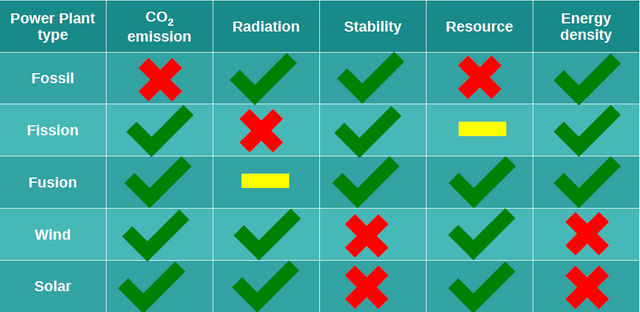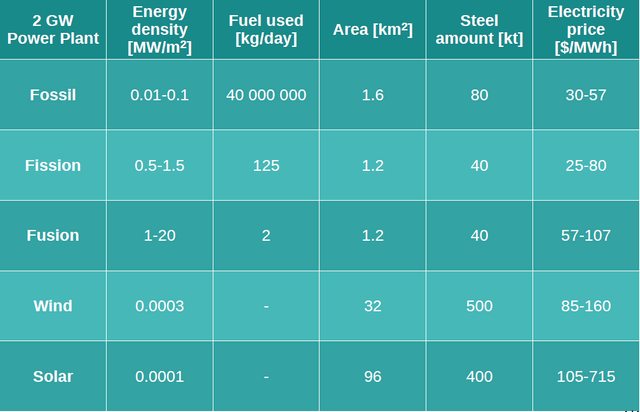(NF.2) Why Nuclear Fusion?
Now I will take a step backwards in respect to my first NF article and try to convince you WHY nuclear fusion is important.
Reading about energy problems and future you might encounter nuclear fusion as a solution. But then you can also read: “Who needs nuclear fusion when we have renewables (solar, wind, etc.)?!”
To make the long story short, I could simply leave you with the next table:

But you are not that lucky. I will try to explain you all addressed topics shown in the above graph.
Energy Issue
Several research papers estimate that the human population will reach about 10 billion in 2050. Unfortunately, this does not imply the 50% larger energy consumption, as one has to take into account economical advance of developing giant countries (such as China, Brazil, Russia, India, etc) and numerous smaller underdeveloped and developing countries. If most of them reach Western World energy consumption we can expect at least threefold increase in the energy demand!
Moreover, from solving the energy issue human civilization could also finalize problems with food and water. Of course, the energy solution has to fulfill a non-existent CO2 emission.
Air Contamination
The atmosphere, and therefore the air we breed in, is over-contaminated via various greenhouse gasses produced by humans. The most common is CO2 gas, which is mostly a consequence of fossil fuel usage for transportation and power production.
The good point is that all other four alternatives fulfill this requirement, so technically it is not an issue. However, plastic (i.e. polymer) industry is extensively involved in the production of various power plant components. This is especially true for the renewables, that is always said to be “zero-level greenhouse” energy source.
Dangerous Irradiation
When somebody says “nuclear” one immediately thinks of a hazardous radiation and mortal technology. However, this is only 100% case with the thrown nuclear bombs, as fission power plant catastrophes with wider consequences could be counted with the fingers from one fist plus one finger: Mayak (USSR) 1957, Sellafield (UK) 1957, Lucens (Switzerland) 1969, Three Mile Island (USA) 1979, Chernobyl (USSR) 1986 and Fukushima (Japan) 2011. It is well known that all of them were the result of the human error. Also, a potential catastrophe in fission power plant is due to the production of the highly radioactive by-product of uranium splitting and possibility for runaway (avalanche expansion) reaction to happen.
On the other side, the nuclear fusion-based power plant cannot have such issues. First, there is no runaway reaction as by turning off plasma in any manner means that machine is really shut down. In other words, it can not go “amok run” as fission core. Nonetheless, there will be radioactive hydrogen-3 (called Tritium) and neutrons that activate machine material. Tritium is not as dangerous as uranium by-products, as it degrades in beta-decay. It is dangerous if significant amount ends up in the drinking water. Luckily amounts per power plant will be so small that the threat should be avoided. Radioactive material from the machine will be radioactive for about a hundred years, so much shorter than uranium by-product. That is why I did not put full “check” or “X” in the box for fusion radiation, but rather "-" as it is in between.
Base Load Production
Ability to produce energy in a predictive manner is very important from the perspective of electricity transmission and manufacturing industries. Seemingly low and short fluctuations in the electrical power can damage whole facility, transmission wiring, and transformer system. Obviously, this is the main drawback with solar and wind energy production, as we can not control the wind, Sun and clouds.
Germany had serious issues with this when transferring from nuclear to renewable. They did solve the problem by drastic changes in the transmission system and factories had to adapt their own infrastructure. That is an expensive and temporal solution, that not all countries are able to do. The ultimate solution would be an extremely efficient energy storage, but unfortunately, it seems like we are very far from it simply due to the basic physics limitations.
(Un)limited Source
Solar and wind are intrinsically unlimited sources as there will always be wind and Sun (or will it?). Fossil fuel depends on its kind: (1) gasoline is said to disappear in 15-30 years, (2) coal a bit longer, (3) while there should be natural gas for 100 years or so.
Time limit for nuclear fission is a bit more complicated as it depends on the technology:
- with the current technology and usage of uranium, it could last for about 100 years
- using depleted uranium could prolong fission as a source to a few more hundreds of years
- handling thorium fission power plants could bring less radiative and more efficient energy source with possible time-length of a few millennia as claimed by its proponents
Finally, nuclear fusion is set in the table limitless which is not absolutely true. There are estimations that there is enough deuterium in the sea water so that nuclear fusion supply us with energy for 2 millions of years. This can be counted as infinity from the perspective of the length of human life. As for this time period, we will for sure either invent baseload renewable or extinct!
Space Usage
Second serious problem with renewables is their space usage, i.e. so-called “energy density”. This problem can be only solved with increasing their efficiency to the level of science fiction from the present perspective.
Moreover, there are some proponents of making solar power plants across unused space, e.g. Sahara desert. A few days ago I encountered an article where they claim that such endeavor in Sahara would even bring rain to the region and make it flourish. From my engineering view, this is ignorant, as one would then reduce energy production.
A little biofnummoreers

Before concluding I would only like to present a few numbers in the table above.
The table shows that renewable sources have also issue with material consumption (which is also not infinite) and price (which is the mover of the whole mankind). One can also see that estimation of fusion price is almost twofold of that from fission and fossil, but it should still be cheaper than the renewables.
In summary from the first table you can see that the fusion has 4.5/5 points, while renewables are at 3/5 (n.b. same as the fossil!). Unfortunately, nuclear fusion power plants are not available yet to us.
Please have in mind that besides running for producing more power, humanity should also give its best to increase in all the aspects – especially in optimizing consumption of water, food, energy, and waste. Reducing all of this would significantly reduce energy need.
With all said, I hope you now understand why obtaining electric power from nuclear fusion should be one of the main technological paths for the whole mankind to take. If you reached the end, please feel free to ask anything in the comments. I will either try to answer you in the comment or even make the new post. If the topic shows popular I will delegate some power to you - I guess that would be fair ;)